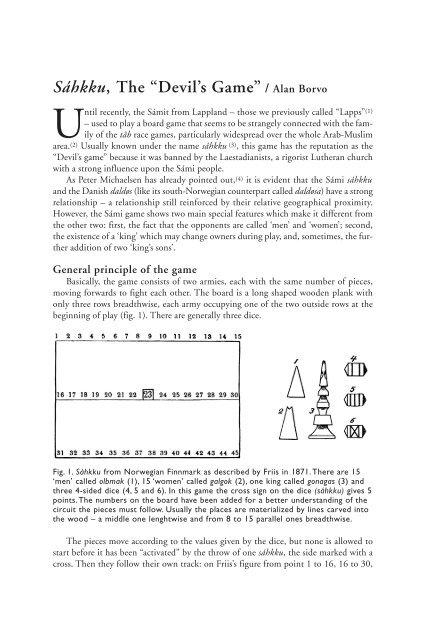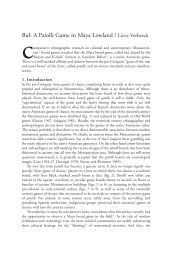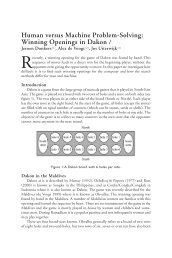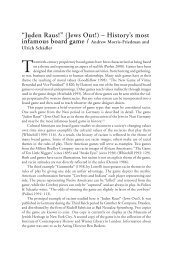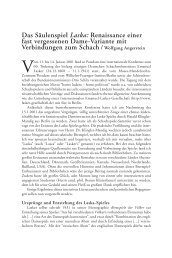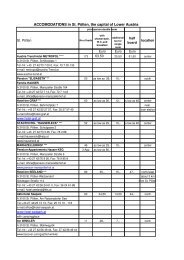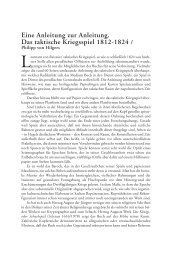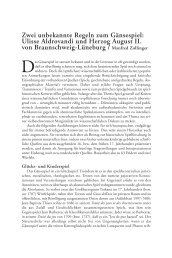Sáhkku, The “Devil's Game” / Alan Borvo - Board Game Studies
Sáhkku, The “Devil's Game” / Alan Borvo - Board Game Studies
Sáhkku, The “Devil's Game” / Alan Borvo - Board Game Studies
Create successful ePaper yourself
Turn your PDF publications into a flip-book with our unique Google optimized e-Paper software.
<strong>Sáhkku</strong>, <strong>The</strong> “Devil’s <strong><strong>Game</strong>”</strong> / <strong>Alan</strong> <strong>Borvo</strong><br />
Until recently, the Sámit from Lappland – those we previously called “Lapps” (1)<br />
– used to play a board game that seems to be strangely connected with the family<br />
of the tâb race games, particularly widespread over the whole Arab-Muslim<br />
area. (2) Usually known under the name sáhkku (3), this game has the reputation as the<br />
“Devil’s game” because it was banned by the Laestadianists, a rigorist Lutheran church<br />
with a strong influence upon the Sámi people.<br />
As Peter Michaelsen has already pointed out, (4) it is evident that the Sámi sáhkku<br />
and the Danish daldøs (like its south-Norwegian counterpart called daldøsa) have a strong<br />
relationship – a relationship still reinforced by their relative geographical proximity.<br />
However, the Sámi game shows two main special features which make it different from<br />
the other two: first, the fact that the opponents are called ‘men’ and ‘women’; second,<br />
the existence of a ‘king’ which may change owners during play, and, sometimes, the further<br />
addition of two ‘king’s sons’.<br />
General principle of the game<br />
Basically, the game consists of two armies, each with the same number of pieces,<br />
moving forwards to fight each other. <strong>The</strong> board is a long shaped wooden plank with<br />
only three rows breadthwise, each army occupying one of the two outside rows at the<br />
beginning of play (fig. 1). <strong>The</strong>re are generally three dice.<br />
Fig. 1. <strong>Sáhkku</strong> from Norwegian Finnmark as described by Friis in 1871.<strong>The</strong>re are 15<br />
‘men’ called olbmak (1), 15 ‘women’ called galgok (2), one king called gonagas (3) and<br />
three 4-sided dice (4, 5 and 6). In this game the cross sign on the dice (sáhkku) gives 5<br />
points.<strong>The</strong> numbers on the board have been added for a better understanding of the<br />
circuit the pieces must follow. Usually the places are materialized by lines carved into<br />
the wood – a middle one lenghtwise and from 8 to 15 parallel ones breadthwise.<br />
<strong>The</strong> pieces move according to the values given by the dice, but none is allowed to<br />
start before it has been “activated” by the throw of one sáhkku, the side marked with a<br />
cross. <strong>The</strong>n they follow their own track: on Friis’s figure from point 1 to 16, 16 to 30,
34<br />
B OARD G AMES S TUDIES 4, 2001<br />
30 to 45, 45 to 31, 31 to 16, 16 to 30 and 30 to 1 for the 1-15 based camp. <strong>The</strong> opponents<br />
do the same but in symmetrical order: point 45 to 30, 30 to 16, 16 to 1, etc. (5)<br />
Each player uses the value given by the dice for moving one, two or three pieces, but<br />
the move of each piece must correspond to the exact values of one, two or three dice. It<br />
is possible to put several pieces on the same point, but, on the next turns, he may not<br />
move them all together with the value of the same die. When one piece arrives at a place<br />
occupied by one or several enemies, this or these are killed and removed from the board.<br />
<strong>The</strong> winner is the player who has killed all his enemies.<br />
Although the pieces must follow their track, the king may go in all four directions.<br />
Placed at the start in the middle of the central row (point 23), it belongs to the first<br />
player who reaches its place. But it may be captured by the opponent who puts one of<br />
his pieces on the point on which it stands. In that case, the king is not killed, but belongs<br />
to the player who has captured it. <strong>The</strong> player who owns the king may move it on his turn<br />
by using the throws given by the dice, in place of or together with one or two pieces. But<br />
the possession of the king does not allow any extra throw.<br />
When an opponent’s piece or king reaches the point just on the right of one’s nonactivated<br />
pieces, all of these are “frozen” until the opposite man or king goes away. But<br />
a non-activated piece may never be killed.<br />
In some local variants, as already remarked, two extra ‘king’s sons’ were used, the<br />
initial places of which were marked with crosses on various old boards, on both sides of<br />
the king’s point in the central row (points 19 and 27). Unfortunately, we know nothing<br />
of their role.<br />
Another interesting item of information which we got from Edmund Johansen (a Sea<br />
Sámi said to be the one who knows best the rules since he frequently played sáhkku<br />
when he was a child) is that the two players may decide not to play “against” but “together”<br />
– apparently a much more tricky affair. In that variant, used only by wise elders,<br />
the two armies had their pieces displayed at the beginning on the same side of the board.<br />
<strong>The</strong> target of the game was the same, but nobody remembers how it was played<br />
(Johansen 2000-2001).<br />
A challenge for the ethnologist<br />
<strong>The</strong> interest of such a game is manifold, for it raises questions whose answers may<br />
help to clarify certain points in our knowledge of the Sámit. Where does this game come<br />
from, and what outside influence does it show? Do its geographical dispersion and the<br />
distribution of its local variants bring anything new concerning the relationships between<br />
the various communities? Is what the Samit added of their own to the game related to<br />
their specific thoughts, social life organization and former religious beliefs?<br />
Solving such questions is a real challenge. <strong>The</strong> sources are scarce and the game has<br />
already almost died out entirely, even if people like Edmund Johansen and his wife Eli<br />
strive to make it come to life again, organizing occasional tournaments in their small village<br />
of Kunes. In Nesseby, too, a coastal city of eastern Norwegian Finnmark on the<br />
north bank of the Varangerfjord, a few old men have made a copy of a 1906 set on exhibition<br />
at the nearby Varanger Samiske Museum, but they had to reconstruct the rules
A. BORVO, SÁHKKU, THE “DEVIL' S G AME” 35<br />
Fig. 2. Old sáhkku set exhibited at the Varanger Samiske Museum (eastern Norwegian<br />
Finnmark), on long-term loan from the Ethnografisk Museum in Oslo.This set seems<br />
to be the one which Isak Saba, the first Sámi to be a Member of the Norwegian<br />
Parliament, offered to the Sámi Collections of the Ethnografisk Museum in 1906.<strong>The</strong><br />
game is played with 15 pieces in each camp, one king and three 4-sided dice with<br />
three sides marked II, III, X and one blank (= 0).<strong>The</strong> board shows 15 short lines but<br />
no long central one.Two crosses on lines 4 and 12 suggest that there might have been<br />
originally two more ‘king’s sons’ as in the Petsamo and Utsjoki sets. April 2001 (Photo<br />
Angélina Vinciguerra, Paris).<br />
from what they could remember from their own youth. Roger Persson, a friend from that<br />
museum, told me that he and his colleagues sometimes used at lunch-break another<br />
reproduction of the same 1906 set for playing a game, confessing that they were often<br />
obliged to make up some of the rules. (6)<br />
Besides such ‘field interviews’, one may draw on museum collections, literature and<br />
vocabulary concerning the game. But, as most of the information collected does not<br />
concern the same place, the same groups or the same aspects of the game, one cannot<br />
even compare them, so that a lot of blank spaces still remain.<br />
<strong>The</strong> number of sáhkku sets now kept in museums is rather limited. (7) At the Norsk<br />
Folkemuseum in Oslo two series of pieces and two apparently complete sets are catalogued.<br />
However, one of these latter two is composed of pieces acquired in 1851<br />
(NFSA.0063) and a board (NFSA.0139) purchased in 1873! <strong>The</strong> other complete set has<br />
been exhibited since 1987 at the Varanger Samiske Museum in Varangerbotn as a longterm<br />
loan (fig. 2). This game seems to be the one which was presented to the Sámi<br />
Collections of the Oslo Ethnografisk Museum in 1906 by Isak Saba from Nesseby, the<br />
first Sámi to be a Member of the Norwegian Parliament. (8)<br />
<strong>The</strong> Tromsø Museum keeps one Russian Skolt Sámi set from Boris Gleb acquired in<br />
1951 (L.500) (fig. 3) and a series of 30 pieces for “sakkospill” of unknown origin (L.1171).<br />
At the National Museum of Finland, in Helsinki, we find some more material:<br />
• A wooden box containing the pieces of a pirccu game, said to have been collected<br />
in Inari or Kittilä (SU 1826:6). This set more accurately seems to be the one made by
36<br />
B OARD G AMES S TUDIES 4, 2001<br />
Fig. 3. <strong>Sáhkku</strong> game collected by Qvigstad at Boris-Gleb, in the coastal Skolt<br />
community of Paatsjoki (Petsamo territory, Russia).<strong>The</strong> board is much more compact<br />
(23 x 37 cm) and its surface is carved so to make squares of different depths.<strong>The</strong>re<br />
are here two series of 8 men each, plus an extra short one, in the middle on the left,<br />
which could perhaps be one of the two “king’s sons” (Tromsø Museum).<br />
Fig. 4. <strong>Game</strong>board, pieces and dice made by an Inari Sámi in 1876.<strong>The</strong> board measures<br />
36.5 x 13.5 cm and shows 15 transverse lines.<strong>The</strong> pieces are: 15 ‘women’ (a) and 15<br />
‘men’ (c).<strong>The</strong>re are crosses on the board marking the places of the king and the two<br />
‘king’s sons’.Three 4-sided dice were used, marked II, III, 4 and X (National Museum of<br />
Finland, SU 1826:6, in Itkonen 1941).
A. BORVO, SÁHKKU, THE “DEVIL' S G AME” 37<br />
an Inari Sámi in 1876 and reproduced in Itkonen 1941 (fig. 4). <strong>The</strong> inside face of the<br />
lid may have been used as a gameboard,<br />
• A compact sized gameboard with 9 x 9 alternated black and white squares, coming<br />
from the Skolt forest community of Suenjel and curiously catalogued as pertsaloudi<br />
– literally “dice game” (SU 4922:189) (fig. 8).<br />
• One set wrongly catalogued as sahmatloudi (from shahmaty, Russian for “chess”)<br />
and said to have been collected among the Suenjel Skolt. It is a typical sáhkku game with<br />
a 75 cm long narrow board, three four-sided dice, 2 x 14 pieces, one king and two king’s<br />
sons (SU 4922:190) (fig. 7).<br />
• A series of 2 x 14 pieces of a pirccu game from Utsjoki, with one king, one king’s son<br />
(?) and three four-sided dice. (9) A hand-written illustrated note dated 1928 is joined to this<br />
series which was sold to the Museum in 1931 by Eliel Lagercrantz (SU 5126:14) (fig. 5).<br />
Fig. 5. <strong>Sáhkku</strong> pieces and dice collected at Utsjoki, Finland.<strong>The</strong> 30 pieces are from six<br />
different types: 1 of type a (king), 14 of type b (men), 3 of type c, 4 of type d, 7 of<br />
type e (=d, but black), 1 of type f.<strong>The</strong> 14 ones of types c, d and e might be ‘women’.<br />
A hand-written note joined to this set says however that the game is played with 15<br />
pieces in each camp.<strong>The</strong> three dice (g) have four sides: one blank (=0), the three<br />
others respectively marked II, III and X (National Museum of Finland, SU 5126:14, in<br />
Itkonen 1941).<br />
Even if Ernst Manker has quoted the game in several of his books (Manker 1954;<br />
Manker 1975), the Nordiska Museet in Stockholm, which he directed, does not keep any<br />
set in its rich Sámi collections. Neither the Karasjok Museum (Norway), nor the Ajtte<br />
Museum in Jokkmokk (Sweden) nor the Inari Siida Museum (Finland) have got any<br />
examples.<br />
Turning now to the literature, the earliest account we have dates from 1871 with the<br />
three pages the Norwegian Friis wrote on sáhkku in his book about Sámi mythology and<br />
folktales (Friis 1871: 164-167). (10) He gives the rules of the game as it was played in
38<br />
B OARD G AMES S TUDIES 4, 2001<br />
Finnmark, with illustrations showing the various game pieces and how they move (fig. 1).<br />
Three years later, the game was mentioned, with simple rules, in the catalogue of a Sámi<br />
exhibition in Göteborg (Sweden).<br />
<strong>The</strong>n we must wait for some 70 years to find something substantial in Lagercrantz’s<br />
and, moreover, Itkonen’s publications (Lagercrantz 1939; Itkonen 1941; Itkonen 1948).<br />
We discover there that the same game, with sometimes two more ‘king’s sons’, is not<br />
only known in Inari and Utsjoki, under the name of pirccu, but in the Skolt Sámi communities<br />
of the Russian border where it is called pertsa(loudi).<br />
In 1953, a four-page article from Yngvar Mejland tells us that sáhkku was actively<br />
played in Nord-Troms too, giving a short presentation of the game as it was played there<br />
(Mejland 1953). However, the major modern contribution to the knowledge of the game<br />
was given in 1999 by Peter Michælsen when he demonstrated the striking resemblence<br />
between the Sámi sáhkku and the Danish daldøs (Michaelsen 1999).<br />
<strong>The</strong> vocabulary used for naming the game and the various events it induces might<br />
certainly reveal some interesting information. Unfortunately, we have had no time until<br />
now for investigating it. What we know from the existing literature is that most of the<br />
words used when playing sáhkku are pure Sámi ones, which seems to indicate that the<br />
game belongs to an already old tradition.<br />
Geographical extension<br />
Before recording the various places where the sáhkku game has been played, we must<br />
say a few words about the Sámit. True aboriginal people of Lappland and fully differentiated<br />
from their Scandinavian and Finnish neighbours, they have until now maintained<br />
the strong original and rather monolithic culture which permitted their ancestors<br />
to survive in a severe arctic environment. This is all the more surprising because of their<br />
small number (about 70,000 now), dispersed over a vast territory (equivalent to about<br />
60% of France), itself cut by several borders and subject to the uses and laws of four<br />
countries (Norway, Sweden, Finland, and Russia).<br />
When looking back over their history, one is struck by their surprising flexibility<br />
which enabled them to face, however hard they might have been, the new conditions of<br />
life caused by the colonization of Lappland: the extinction of wild reindeer, taxes to be<br />
paid simultaneously to several states, borders moved or even closed, newcomers settling<br />
on their grazing lands, etc. Organized in small communities gathering a few families for<br />
mutual aid, they adapted themselves to what nature could provide them with: sea-fishing<br />
and light farming for the groups disseminated on the Norwegian coast (Sea Sámit),<br />
reindeer-breeding for most of the inland ones (Mountain Sámit), lake and river-fishing<br />
in the northern Finnish Utsjoki-Inari area (Fishing Sámit), and mixed small reindeerbreeding<br />
and river-fishing in the forest zones (Forest Sámit). <strong>The</strong> Russian Skolt Sámit,<br />
of Orthodox persuasion unlike the others who are Lutherans, form a separate group<br />
including both coastal and forest communities.<br />
Keeping that in mind, it can be said that sáhkku was mainly known in a narrow coastal<br />
fringe all along the Arctic shore from Nord-Troms (Tromsø area) in the west to the Russian<br />
Petsamo Peninsula in the east, in other words into Sea Sámi and Skolt communities.
A. BORVO, SÁHKKU, THE “DEVIL' S G AME” 39<br />
With regard to Nord-Troms, Yngvar Mejland (Mejland 1953) writes that the game<br />
had been in use “until recent times” in various places. His great-grandfather, Nils Olsen,<br />
from the tiny Hauköya island at the mouth of the Kvænangenfjord, knew it since he was<br />
a child. He adds that sáhkku was known also in Nordreisa, between Lyngen and<br />
Kvænangen. This is confirmed by Edmund Johansen (Johansen 2000-2001), who says<br />
that it had been played in the Lyngenfjord area until the 1950s.<br />
As for Finnmark, the northernmost province of Norway, Edmund Johansen says that<br />
the game was the same in Sørøya Island west of Hammerfest. One of the sets kept by the<br />
Norsk Folkesmuseum in Oslo comes from Komagfjord, a small seaside place opposite the<br />
nearby island of Seiland. East of Cape North, one finds the sáhkku again in Laksefjord<br />
P o l a r C i r c l e<br />
Bergen<br />
Jaeren<br />
Thy<br />
DENMARK<br />
Fanø<br />
Trondheim<br />
NORWAY<br />
Mors<br />
Oslo<br />
SWEDEN<br />
Copenhagen<br />
Sørøya<br />
Hauköya<br />
Kunes Nesseby<br />
Nordreisa<br />
Neiden<br />
Utsjoki<br />
Boris-Gleb<br />
Lyngen<br />
Inari Suenjel Kola<br />
Nord-Troms<br />
Peninsula<br />
Kvikkjokk (?)<br />
Stockholm<br />
Bornholm<br />
Gulf<br />
of<br />
Bothnia<br />
Baltic<br />
Sea<br />
FINLAND<br />
Helsinki<br />
RUSSIA<br />
St. Petersburg<br />
0 100 200 300 400 500<br />
Fig. 6. Geographical expansion of the game.<strong>The</strong> thick gray line is the southern limit of<br />
the territory where the Sámit live.<strong>The</strong> gray squares are the places where sáhkku is<br />
known to have been played.<strong>The</strong> black triangles show the places where the Norwegian<br />
daldøsa and the Danish daldøs have been observed. (Map:Thierry Depaulis)<br />
km
40<br />
B OARD G AMES S TUDIES 4, 2001<br />
where Edmund lives. “In the beginning of the 50s and until 1966, he tells, the game was<br />
still played actively in Kunes, Bekkarfjord and Skjötningberg, three Sea Sámi villages in<br />
the fjord. Prior to 1975, the only road coming from Børselv was cut off for the whole<br />
winter, totally isolating the Nordkinn peninsula on the coast of which these villages are<br />
located. So, playing sáhkku helped people to fill in the long winter nights. <strong>The</strong> game<br />
was known on the coast among Sea Sámit but not among Mountain Sámit, who came<br />
up here with their reindeer for their summer camp.” (11)<br />
Continuing our way eastward, we reach the Varanger peninsula, on the west coast of<br />
which we know sáhkku to have been played in Trollfjord still in 1903. (12) On the south<br />
coast of that peninsula, Nesseby too has been an active center where the game was played.<br />
<strong>The</strong> set exhibited at the Varanger Samiske Museum in Varangerbotn (fig. 2) might come<br />
from there.<br />
Still following the Arctic coast on the southern bank of the Varangerfjord, we reach<br />
the Skolt Sámi area in Neiden, where some people remember the game still being played<br />
at the beginning of the 20th century. In a letter to the Varanger Samiske Museum dated<br />
April 25, 1996, Aud Mathisen said that her mother, Maila Mathisen, then 82 years old,<br />
recalled that, when she was still a child in Neiden, the game was called pirttsa and people<br />
said it was a Finnish game.<br />
Fig. 7. <strong>Game</strong>board, pieces and dice from the same coastal Skolt community of Paatsjoki<br />
(Petsamo territory, Russia) as in fig. 3.<strong>The</strong> board measures 75 x 14 cm and shows 15<br />
transverse lines.<strong>The</strong> pieces are of five types: 1 of type a (king), 1 of type b, 14 of type c<br />
(‘women’), 1 of type d and 14 of type e (‘men’).Types b and d seem to correspond to<br />
the ‘king’s sons’.<strong>The</strong> three 4-sided dice (f) are marked II, III, :: (=4) and X (National<br />
Museum of Finland, SU 4922:190, in Itkonen 1941).
A. BORVO, SÁHKKU, THE “DEVIL' S G AME” 41<br />
From farther east over the Russian border, from the Petsamo territory which used to<br />
belong to Finland between the two world wars, we know three sets. One, in the Helsinki<br />
Museum (SU 4922:190), is a pure sáhkku game on a long plank (75 x 14 cm) (fig. 7).<br />
It is misleadingly catalogued as sahmatloudi (from shahmaty, Russian name for “chess”)<br />
and said to have been collected in Suenjel, a forest community broken up by the last war.<br />
<strong>The</strong> second example, in the Tromsø Museum (L 500), comes from Boris-Gleb, the main<br />
village of the coastal Pasvik community. Here the board is much more compact (23 x 37<br />
cm) and its surface is cut out to make up squares of different depths. But the king, the<br />
dice and the pieces (2 x 8) show it is a real sáhkku set (fig. 3). (13) <strong>The</strong> third specimen is<br />
just a gameboard kept in the collections of the Helsinki Museum (SU 4922:189) and catalogued<br />
as pertsaloudi. It too has a compact form, showing 81 squares (9 x 9), alternately<br />
black and white, and comes from Suenjel (fig. 8).<br />
Fig. 8. <strong>Game</strong>board collected in the Skolt inland community of Suenjel and catalogued<br />
as pertsaloudi (i.e. “dice game”) although it is more likely a shahmatloudi, i.e. a “chess<br />
game”. Note the basket pattern formed by the black squares (National Museum of<br />
Finland, SU 4922:189). (CAD drawing:Thierry Depaulis)<br />
Even if it seems that there has been an inversion about the names (SU 4922.190 is a<br />
pertsaloudi and SU 4922.189 is a shahmatloudi, the Skolt version of chess with black and<br />
white squares), (14) this third board is interesting because, with its compact shape and<br />
squares, it resembles the second board which has its sáhkku king, three dice and two series<br />
of eight sáhkku pieces. One may imagine that perhaps some of the Skolt could have used<br />
the same board for playing both games, a supposition which has to be confirmed.<br />
If we except the Suenjel games, all the places quoted until now are located directly<br />
on the coast, and, as we have said earlier, even the Karasjok Mountain Sámit, who
42<br />
B OARD G AMES S TUDIES 4, 2001<br />
camped near Kunes on their summer migration, did not play sáhkku. In Kautokeino, the<br />
other important community of Norwegian Mountain Sámit, the game is also completely<br />
unknown. It is obvious that it is mainly a seamen’s game, but it has been in use in some<br />
few places inland too. In Kvikkjokk, in Swedish Lappland, the word sahkku used to be<br />
known, referring to some kind of board for playing. From Finland, we have two of the<br />
sets kept by the National Museum in Helsinki. One was made by an Inari Sami in 1876,<br />
the other collected in Utsjoki in 1928 by Eliel Lagercrantz. In these two places, the game<br />
is called birccu or birccut – which means “die” or “dice”. It may be noticed that Inari<br />
and Utsjoki are both located in areas where, beside a few families of Mountain Sámit,<br />
most of the population is composed of Fishing Sámit.<br />
Let us come back to the sea and end up our survey at Spitzberg, where it seems that<br />
the sáhkku game might have been known too. In 1890 a Swedish archaeologist excavating<br />
in that island found a piece which he thought was a chess king. But any Russian<br />
piece who was there would have corrected this, saying that it was a sáhkku king. This<br />
story is by no means nonsense, for the Sea Sámit may perfectly well have frequented the<br />
archipelago. As the sáhkku king was generally carved in reindeer horn or cast from metal,<br />
it could have been the only piece that survived from a full set.<br />
Permanent features and local variants<br />
From the literature we understand there has been a certain number of local variants<br />
of the game, but we cannot describe each one in detail. (15) Our purpose here is just to<br />
try to distinguish between what is common and what is different in the various rules.<br />
• <strong>The</strong> dice<br />
Three dice are generally used, except in Nord-Troms where Mejland said they were<br />
only two. According to old people from Nesseby, who remembered the game, dice used<br />
to be cast into a bowl, not on a flat surface. Such dice were carved in wood like teetotums<br />
(26 x 26 x 42 mm in the Varanger / Nesseby set), with two of their end sides shaped<br />
like pyramids. All have four marked faces, and one of these always shows an “X” (sáhkku).<br />
<strong>The</strong> value of that “X” varies from place to place, either 1 or 5. In the Kunes (eastern<br />
Finnmark) rules, its value is 1, just like the “X” in the Norwegian daldøsa game from<br />
Jaeren and like the “A” in the Danish daldøs. In Friis’s description from Finnmark, it is<br />
worth 5 and it seems to have been the same in the game from Utsjoki.<br />
<strong>The</strong> values of the other marked faces vary too. In Friis’s version one is plain (=0) and<br />
the others are marked II (=2), III (=3), IIII (=4) and X (=5), the latter being coloured<br />
black. We find the same values in Kunes, Varanger and Utsjoki. (16) In Nord-Troms,<br />
however, they are 1-2-3-X; in Boris-Gleb and Inari, 2-3-4-X.<br />
In Kunes, as in Friis’s account, values of the dice could be used separately for moving<br />
several pieces and the king if it is owned. But they could also be accumulated for<br />
moving just one piece or the king. This was not allowed in Nord-Troms where each<br />
piece had to move according to the value of one die.<br />
In Nord-Troms and in Utsjoki, extra throws were granted to the player who threw<br />
one or several consecutive sahkku, an advantage which does not exist in the Kunes rules.
A. BORVO, SÁHKKU, THE “DEVIL' S G AME” 43<br />
• <strong>The</strong> pieces<br />
<strong>The</strong> two series of gamespieces are generally called olbmát (men) and gálgut (women),<br />
even if Mejland calls them “soldiers” in Nord-Troms. Carved in wood, they are differentiated<br />
by their shapes. In the Varanger Samiske Museum set (fig. 2), the pyramids of<br />
the ‘men’ are topped with a small sphere while the ‘women’ have a crook-shaped form.<br />
Both might represent old-fashioned traditional Sámi hats: the cone-shaped bobbletopped<br />
one of the men and the women’s laggjo which had been forbidden by Laestadianists<br />
for it would have symbolized the “Devil’s horn”! Everywhere else they are much<br />
simpler, the ‘men’ usually are shaped as sharp-pointed four-sided pyramids, and the<br />
‘women’ like steep-roofed houses, with a notch on the top.<br />
<strong>The</strong> size of the pieces does not vary so much. In Kunes, both ‘men’ and ‘women’<br />
measure ca 25 mm. In the Varanger set which we had in our hands, the ‘men’ are 38 mm<br />
high and the ‘women’ 33 mm. In comparison the king is 94 mm on a square base of<br />
26 mm width.<br />
In Inari as well as in Finnmark (Friis’s description, Kunes and Nesseby-Varanger), the<br />
pieces are 15 in each camp. However, Lagercrantz says that in 1928 in the Finnmark<br />
fisheries people used to play with 20 men and 20 women. In Nord-Troms, according to<br />
Mejland, there were only 12 of each. In the Skolt Paatsjoki set they were 14, and only 8<br />
in the Skolt Boris-Gleb example. (17) As far as the Utsjoki set is concerned, even if only<br />
2x14 gamespieces have been preserved, the hand-written note – be it by Lagercrantz or<br />
by Itkonen – joined to it does mention 15 in each side.<br />
• <strong>The</strong> board<br />
<strong>The</strong> standard board consists of a long narrow wooden plank on which 15 parallel<br />
lines are cut widthwise and sometimes one perpendicular middle line lengthwise. At the<br />
intersection of the long middle line with the eighth short line, i.e. at the center of the<br />
board, a cross is engraved: this is where the king stands at the beginning of the game. <strong>The</strong><br />
size of the board varies from about 30 x 15 cm (Kunes and Inari) up to 56 x 15 cm<br />
(Varanger) and even 75 x 14 cm (Paatsjoki).<br />
Besides this type, which is the most common, the Skolt area shows two other models<br />
where the shape is much more compact (37 x 23 cm for the Boris-Gleb set at the<br />
Tromsø Museum). <strong>The</strong>se two boards have no carved lines but they have squares (9 x9)<br />
that are differentiated either by their depth or by a black-and-white pattern. Even if the<br />
Boris-Gleb set is displayed with sáhkku pieces which seem to be of the same origin as the<br />
board, it is evident that these two boards were originally made for an other type of game<br />
more similar to draughts or chess.<br />
When comparing the various real sáhkku sets, one notices that in some of them<br />
(Nord-Troms and perhaps Utsjoki) the number of pieces per player is the same as the<br />
number of lines less one. Maybe it is this feature which led Itkonen to think the pieces<br />
were placed between the lines at the beginning of the game and not on the lines. Since<br />
the place of the king was marked at an intersection of the middle line and not between<br />
two lines he thought that, once arrived on this middle line, the men had to move from<br />
line to line. We saw that it was not the case in Kunes, where, wherever they are, the
44<br />
B OARD G AMES S TUDIES 4, 2001<br />
pieces always move from line to line. In Nord-Troms, however, where there are 12 men<br />
for 13 squares, we know from Mejland that, at the beginning, the place at the right of<br />
each player was empty: it was used for “activating” and playing the first piece.<br />
• <strong>The</strong> king<br />
<strong>The</strong> tallest and the most powerful of the pieces is the sáhkku king (gonagas), a pure<br />
Sámi addition to the daldøs(a)-type games. At the start of the play, it is placed in the center<br />
of the board which is marked with a crossed square called the “castle”. It has roughly<br />
the shape of a sharp 4-sided pyramid, either with simple notches on its ridges or<br />
showing several superposed tiers, some of them decorated with crosses – the sáhkku sign.<br />
An exception to this general type is the piece shown in Mejland’s article for Nord-Troms<br />
where the king is topped with a kind of bishop’s crook, a sign which could refer to the<br />
times when the Catholic church of Trondheim was still very influential there.<br />
Except in the Utsjoki variant where it may be killed, the king is a powerful piece, able<br />
to move in all four directions. So it is important to capture it. In Nord-Troms, Kunes<br />
and Utsjoki the king belongs to the first player who reaches the point where it is situated.<br />
According to Friis, in Finnmark, the player who first threw a sáhkku not only won<br />
the king, but was allowed an extra throw with the three dice.<br />
• <strong>The</strong> ‘king’s sons’<br />
We know that king’s sons did exist from the two crosses which appear on several<br />
sáhkku boards (Varanger, Utsjoki, Inari and Paatsjoki), four lines on each side of the<br />
king’s place, but we have no idea about how they were used. From the differentiated<br />
shape of the only pieces kept in a museum (fig. 7), each one higher but apparently related<br />
in shape to the pieces of the two armies, we may guess that each player had his own.<br />
According to Itkonen, these would correspond to the ‘king’s sons’ of the Sámi tablut<br />
game from Frostviken (Swedish Lappland).<br />
<strong>The</strong> sáhkku king: god or devil?<br />
<strong>The</strong> social organization of the Sámit never had a king. <strong>The</strong>re is one, however, in the<br />
Sámi game tablut, and moreover there are two ‘king’s sons’ in the Frostviken variants<br />
from Swedish Jämtland, just like in sáhkku. It has to be noted that this tablut king is<br />
called “king of the Swedes” and not “Sámi king”, which may find an explanation into<br />
the fact that tablut is not a genuine Sámi game but derives from the old Viking game<br />
hnefatafl.<br />
<strong>The</strong> sáhkku king and king’s sons are obviously connected with the tablut pieces, a<br />
proposition further reinforced by the fact that the pieces in the two games often have<br />
similar forms. As far as the king is concerned, it seems that the sáhkku king had a specific<br />
status. It could be in wood but more frequently in a harder material, such as reindeer<br />
horn, lead or walrus ivory, that kept it from decaying. It was decorated with several<br />
“Xs”, the sáhkku sign. In Kunes, it was topped with a four-pointed cap as the one that<br />
Finnmarks and Finnish Sámit wear, derived from the square chapka of the Russian<br />
Pomor merchants who traded along the coast.
A. BORVO, SÁHKKU, THE “DEVIL' S G AME” 45<br />
Edmund Johansen (Johansen 2000-2001) remembers that, when he was still a child<br />
in Kunes, it was considered “bad” to play sáhkku. <strong>The</strong> children could play cards but<br />
sáhkku was strictly forbidden for it was said to be the “Devil’s game”. As a matter of fact,<br />
it seems that followers of Lars Levi Læstadius, the very rigorous Lutheran pastor who<br />
evangelized the Sámit in the 19th century, pronounced a kind of ban on this game.<br />
For Edmund Johansen the reason for such a ban was that the game of sáhkku alluded<br />
to old Sámi shamanic beliefs, against which Laestadianists fought actively. <strong>The</strong> crosses<br />
(sáhkku signs) with which the sáhkku king is decorated were symbols of the sun, which<br />
the old Sámit worshipped as the center of the world. “Our ancestors,” Johansen explains,<br />
“called it gonagas from the Norwegian word (konge, “king”) simply because, as they had<br />
no king, they had no word in their language for calling it. But this king may perfectly<br />
well have meant god with the signification the Sámit give to that word, i.e. a natural<br />
power, neither good nor bad, whith whom one has to deal anyway by making offerings.<br />
In our language sáhkku means ‘penalty’. You may know the Sámit often give things new<br />
names just to avoid the minister’s wrath, so they could say penalty while they really<br />
thought of offering.”<br />
In confirmation of such a theory there is at the Nordiska Museet in Stockholm the<br />
reconstruction of an old Sámi offering-place with a cross-marked wooden idol the general<br />
shape of which strangely resembles the sáhkku king (fig. 9).<br />
However pertinent our<br />
informant may be, it is obvious<br />
that the game of sáhkku has<br />
more than a smack of heresy.<br />
“One day,” tells Edmund Johansen,<br />
“a man found a leaden<br />
sáhkku king which he decided to<br />
use as a sinker for fishing. He<br />
said he knew it was the Devil,<br />
but he added that such a devil<br />
could make him lucky when<br />
fishing”.<br />
Fig. 9. Reconstruction of an<br />
old Sámi offering place with a<br />
cross-marked wooden idol the<br />
general shape of which looks<br />
like some sáhkku kings<br />
(Nordiska Museet, Stockholm).
46<br />
B OARD G AMES S TUDIES 4, 2001<br />
A still mysterious origin<br />
At the present stage of our research, it would be hazardous to formulate any theory<br />
about the origins of sáhkku. <strong>The</strong> only statement which makes sense is that the game is<br />
definitely not a true Sámi creation. <strong>The</strong> Sámi culture is so homogeneous that, if it had<br />
been so, the game would have been known in the whole Sámi area and not be limited<br />
to the fringes of the Arctic shores. As a matter of fact it seems that some Sámi groups<br />
invented a new game by introducing a king (and even two king’s sons) to a daldøs(a)-type<br />
game, both being evidently closely related. Such additions make the game much more<br />
tactical and attractive. But the concept of “king” has nothing to do with the Sámi tradition.<br />
As previously stated, when it appears in tablut, another Sámi board game from<br />
Sweden, sometimes also with two king’s sons, it is called “King of the Swedes” – not a<br />
Sámi king, and it fights the “Moscovites”. Tablut is thought to be one of the only survivors<br />
of the old Viking hnefatafl game. So the Sámi Arctic coastal groups to whom we<br />
seem to owe sáhkku would also have known tablut, although tablut was played in southern<br />
Swedish Lappland only; or they may have adopted the king and its sons directly<br />
from hnefatafl.<br />
So there are still a lot of questions to answer. As for how the original daldøs(a)-type<br />
game was introduced to Lappland, we offer here three possibilities, all each taking into<br />
account the remarkable present geographical concentration of the game in the Arctic<br />
shores of Troms and Finnmark:<br />
• <strong>The</strong> Viking track. This is of course the most satisfactory hypothesis since daldøs(a)<br />
has survived until now in western Denmark and southern Norway. <strong>The</strong> presence of the<br />
king and king’s sons in sáhkku, in relationship to the old Viking hnefatafl ones, seems to<br />
be another favourable argument. For centuries, but mainly around the 10th century, the<br />
western Viking ships made frequent sea raids up to the North where they might have<br />
taught local populations some kind of daldøs(a) game. If so, why is there – as far as we<br />
know – no survival of such a game on the 1,300 km-long coast between Jæren and<br />
Tromsø, even among the southern Sámit living there? And why would only the Sea Sámit<br />
from Troms and Finnmark have maintained its tradition? Is that just because they invented<br />
a mixture of hnefatafl and daldøs(a) which made the game much more exciting?<br />
• <strong>The</strong> Pomor track. From ca 1740 until the beginning of the 20th century, Russian<br />
merchants from Archangel called Pomors used to come every year to the coast of<br />
Northern Scandinavia on board heavily-laden sailing ships carrying flour, timber and<br />
hardware. <strong>The</strong>y exchanged their freight for dried fish and other local productions with<br />
the Sea Sámit who had no other source for supplies. Trading was done in “Pomor”, a kind<br />
of Nordic Creole made of Russian, Norwegian and Sámi words, which was perfectly<br />
understood from Tromsø to Murmansk. Such a regular trade induced the Sea Sámit to<br />
adopt several cultural features from their yearly visitors, among other things their curious<br />
four-pointed caps. <strong>The</strong> daldøs(a)-type game could have been one of those, but, as far<br />
as we know, there is no evidence that such a game has ever been played in Northern<br />
Russia.
A. BORVO, SÁHKKU, THE “DEVIL' S G AME” 47<br />
• <strong>The</strong> Kvaen track. If sáhkku did not come by sea then it could have been brought<br />
by the Kvaen, Finnish emigrants who, around the year 1800, came in large numbers to<br />
settle in the ends of the fjords of Nord-Troms and Finnmark. In 1913, they numbered<br />
no less than 7,000 people in these two provinces. In several areas of eastern Finnmark,<br />
they even formed the majority of the population. Among the main places where they<br />
concentrated are Skibotn, east of Tromsø, Nordreisa, Inari, Utsjoki, Vadsö, Bugøyfjord<br />
and Neiden, the latter three on the Varangerfjord, all precisely spots where we know<br />
sáhkku was played. Besides such geographical agreement, we know from a Neiden<br />
woman’s testimony that, at the beginning of the 20th century, the game was said to be<br />
a Finnish one. <strong>The</strong> fact that, in the Finnish language, the word sakko has the same “penalty”<br />
meaning as its Sámi equivalent would also support the idea of a Finnish origin. But,<br />
just as with the Russian track, we have so far never heard that this kind of game was<br />
known anywhere in central or southern Finland.<br />
This short analysis shows how difficult it is to explain the presence of such a ‘tâb’<br />
game such a long way from its original area. Even if sáhkku appears to be derived from<br />
a daldøs(a)-type model, it remains to be demonstrated how this model reached the<br />
Fenno-Scandic area.<br />
References<br />
Drake, Sigrid 1918. Västerbottenslapparna under förra Hälften av 1800-talet. Uppsala.<br />
Friis, J.A. 1871. Lappisk mythologi, eventyr og folkesagn. Christiania (Oslo).<br />
Itkonen, Toivo Immanuel 1941. Die Spiele, Unterhaltungen und Kraftproben der<br />
Lappen, In: Journal de la Société finno-ougrienne, 51,4: 1-133 (§106. Würfel. § 107-<br />
108. Die Brettspiele).<br />
Itkonen, Toivo Immanuel 1948. Suomen Lappalaiset vuoteen 1945, I-II. Poorvo-Helsinki.<br />
Johansen, Edmund 2000-2001. Personal interviews of Edmund Johansen in Kunes, eastern<br />
Norwegian Finnmark, May 2000 and April 2001.<br />
Keyland, Nils 1921. Dablot prejesne och dablot duoljesne. Tvänne lappska spel från<br />
Frostviken, förklarade och avbildade, In: Etnologiska Studier tillägnade Nils Edvard<br />
Hammarstedt, 3/3, Göteborg: 35-47.<br />
Lagercrantz, Eliel 1939. Lappischer Wortschatz, Helsinki: No. 4945.<br />
Manker, Ernst 1954. Les Lapons des montagnes suédoises, Paris.<br />
Manker, Ernst 1975. De åtta årstidernas folk. Göteborg.<br />
Mejland, Yngvar 1953. Sakko, In: By og Bygd (Oslo), 8: 00-00.<br />
Michaelsen, Peter 1999. Daldøs og Sakku, to gamle nordiske spil med fjerne slaektinge,<br />
In: Ord & Sag, 19: 15-28<br />
Schefferus, Johannes 1673. Lapponia, Frankfurt.<br />
Notes<br />
1. <strong>The</strong> word Lapp is a nickname given by the first Scandinavian settlers who met the Sámit. In<br />
the old northern dialects, it meant something like “rags”. Sometimes still called Finner in<br />
Norway – Finner for “Finnish”, although these two populations differ quite a lot – the Sámit
48<br />
B OARD G AMES S TUDIES 4, 2001<br />
(Sámi in the singular) have now recovered, at least in the Fenno-Scandic area, the name they<br />
have always given to themselves.<br />
2. See Thierry Depaulis, “Jeux de parcours du monde arabo-musulman”, this volume.<br />
3. In Sámegiella, the Fenno-Ugrian language of the Sámit, the “á” is pronounced like a in the<br />
English “sad”, and the “u” is pronounced . So, the word sáhkku (meaning “penalty”)<br />
must be pronounced . <strong>The</strong> letter “c” being the equivalent of “ts”, bircu (die) and<br />
birccut (dice) – two other names given to the game in the Utsjoki-Inari Finnish area, have to<br />
be articulated and , which sound rather like the word percc’ (die),<br />
pronounced , used by the Skolt Sámit for naming the game.<br />
4. Michaelsen 1999 and this volume.<br />
5. Of course, these numbers do not appear on the board. <strong>The</strong>y are simply given here to explain<br />
how the pieces move.<br />
6. In April 2001 Roger Persson told us that the rules they used were in fact those published by<br />
Friis 130 years ago. When playing a real game, these rules appeared rather incomplete.<br />
7. We want to specially thank here Mrs. Nina Puurunen, Curator of the National Museum of<br />
Finland in Helsinki; Mrs. Elisabeth Brundin, Curator of the Nordiska Museet in Stockholm;<br />
Mr. Leif Pareli, Curator of the Sámi Collection at the Norsk Folkemuseum in Oslo; Mr. Terje<br />
Brantenberg, from the Tromsø Museum; Mr. Roger Persson, from the Varanger Sámiske<br />
Museum in Varangerbotn – all of whom provided co-operative and efficient help.<br />
8. According to curator Leif Pareli, from Oslo, there is an irregularity in the numbers in the catalogue<br />
so that set could belong to another collection acquired in 1906. However, he says,<br />
“I find it more likely that this game was actually acquired through Isak Saba”.<br />
9. Peter Michaelsen thinks that the so-called king’s son in fact is the missing king of the Utsjoki<br />
game (SU 128:14), for it is identical with the drawing in Itkonen 1941: fig. 34. It would have<br />
been misplaced by the museum.<br />
10. Two centuries earlier, Schefferus wrote that similar dice were used by the so-called Lapps, but<br />
he did not mention any board game related to them.<br />
11. Such a strictly coastal distribution looks very similar to the one we observed for the French<br />
aluette, an old seamen’s card game played from Cherbourg to Bordeaux on a narrow strip all<br />
along the coast and the banks of the Loire river up to Orléans (see <strong>Alan</strong> <strong>Borvo</strong>, Anatomie d’un<br />
jeu de cartes: l’aluette ou le jeu de la vache, Nantes, 1977).<br />
12. Konrad Nielsen, Lapp Dictionnary (s.v. “<strong>Sáhkku</strong>”).<br />
13. However, one cannot dismiss the idea that the Tromsø Museum photograph shows an arrangement<br />
made out of an incomplete sáhkku set (9 ‘women’, 8 ‘men’, 1 king, 3 dice) “artistically”<br />
set up on a draughtsboard! (Editor)<br />
14. Such an inversion is confirmed by the fact that the real Skolt sáhkku game wrongly named sahmatloudi<br />
in the catalog of the Museum (SU 4922:190) is said to come from Suenjel, although<br />
Itkonen, who himself collected these games in 1913, presents this one as coming from Patsjoki<br />
(Itkonen 1941).<br />
15. <strong>The</strong> only rules we are sure of are the ones of the Kunes variant which we give hereafter.<br />
16. In Utsjoki too, the X-marked side was coloured black.<br />
17. <strong>The</strong> latest set seems to be a shorter version of sáhkku played on a board made for an other<br />
game. (But see Editor’s remark note 13.)
A. BORVO, SÁHKKU, THE “DEVIL' S G AME” 49<br />
Appendix<br />
Rules of sáhkku<br />
(Kunes variant, eastern Norwegian Finnmark)<br />
<strong>The</strong> rules we give here have been collected directly from Edmund Johansen, a Sea<br />
Sámi from Kunes who had been actively playing the game there until the 1950s. <strong>The</strong>y<br />
have been written down after we played several games together in April 2001. As we<br />
wanted to provide scholars and players with a complete useful account, some parts of this<br />
text necessarily repeat what has been said earlier in the main article. We apologize for it.<br />
Material<br />
• One gameboard made of a small wooden plank (30 x 15 x 1 cm) on which are<br />
carved 15 parallel lines widthwise and one perpendicular central line lenghwise. Just at<br />
the center, at the intersection of the long central line with the eighth short line a cross<br />
is engraved: it is where the king stands at the beginning of the game.<br />
• Fifteen ‘men’ (olbmát in Sámi), ca 25 mm high square wooden pieces, cut in the<br />
shape of long 4-sided pyramids.<br />
• Fifteen ‘women’ (gálgut in Sámi), square wooden pieces of the same size as the previous<br />
ones, but cut in the shape of steep-roofed houses with a notch on the top.<br />
Fig. 10. <strong>Sáhkku</strong> lesson given to the author by Edmund Johansen in Kunes (eastern<br />
Norwegian Finnmark) in April 2001. Edmund is considered the best expert on the<br />
rules of the game (Photo Angélina Vinciguerra, Paris).
50<br />
B OARD G AMES S TUDIES 4, 2001<br />
• One king (gonagas in Sámi), a ca 45 mm high square piece made of wood, reindeer<br />
horn or cast tin. It shows four superposed tiers, the second ornamented with four crosses<br />
(the sáhkku sign), and the fourth cut as a four-pointed cap.<br />
• Three dice (birccut in Sámi), cut from wood and longer than the usual ones. <strong>The</strong>y<br />
have only four scoring sides, the two ends forming 4-sided pyramids. <strong>The</strong> values marked<br />
on the sides are: X (sáhkku = 1), II (=2) and III (=3). <strong>The</strong> last side is blank (=0). Usually<br />
the dice are thrown into a wooden bowl.<br />
Object<br />
<strong>The</strong> game is for two players. <strong>The</strong> aim is to “kill” all the opponent’s pieces or to prevent<br />
him from “activating” whatever pieces he has left.<br />
Beginning<br />
<strong>The</strong> board is placed between the two players with its long sides in front of them.<br />
Each chooses the side with which he will play – the ‘men’ or the ‘women’. He puts them<br />
in line on the side of the board in front of him, each man on the end of one of the fifteen<br />
parallel lines. <strong>The</strong> king is placed on the central cross.<br />
In order to determine who begins, each player throws a single die. <strong>The</strong> first to get a<br />
sáhkku (the X-marked side) plays first.<br />
At the beginning, the pieces are considered as locked in their places. To “activate” any<br />
one of them, a player must get three sáhkku in three successive throws using the three<br />
dice. After each throw the one or two sáhkku points obtained are put aside and the<br />
remaining die or dice are thrown again. Each player tries in turn. As soon as he has got<br />
three sáhkku, the player may “activate” some of his pieces: either (1) the first three on his<br />
right, moving each one jump, or (2) only the first, moving it three jumps, or (3) the two<br />
first moving one one jump and the other two jumps.<br />
Moving the pieces<br />
Throughout the game, no piece may leave its original place without being activated<br />
by a sáhkku, which will allow it to move one point (or line). <strong>The</strong> pieces must follow a<br />
track which leads them to meet the opponents, without any possibility of moving backward.<br />
<strong>The</strong> figure below will help the reader understand how they have to move. <strong>The</strong><br />
pieces initially located from 01 to 15 move from the left to the right of their owner, then<br />
from 15 to 16, from 16 to 30, from 30 to 31, from 31 to 45, from 45 to 16, from 16 to<br />
30, and from 30 to 01. <strong>The</strong> opponents move similarly, but in the opposite direction:<br />
from 45 to 31, from 31 to 30, from 30 to 16, from 16 to 15, from 15 to 01, etc.<br />
Each player throws the three dice in turn. He may use the values given by them either<br />
for activating or moving one, two or three of his pieces. But the move of each piece must<br />
correspond to the exact numbers given by one, two or three dice. For example, a throw<br />
of X-III-blank (total = 4) does not allow to move two men two lines each: the player must<br />
move one man one line (for the X) and another one three lines (for the III).<br />
It is possible for a player to put one or several pieces in a place already occupied by<br />
one or several of his own pieces, with the risk of having them all killed if the opponent<br />
comes to this very place. Pieces may also jump over one or several pieces, of either side.
A. BORVO, SÁHKKU, THE “DEVIL' S G AME” 51<br />
31 32 33 34 35 36 37 38 39 40 41 42 43 44 45<br />
30 29 28 27 26 25 24 23 22 21 20 19 18 17 16<br />
01 02 03 04 05 06 07 08 09 10 11 12 13 14 15<br />
Killing the opponent’s pieces<br />
When a piece comes to a place already occupied by one or several of the opponent’s<br />
pieces, the latter is or are killed and permanently removed from the board. Only already<br />
activated pieces may be killed. Killed pieces cannot be re-entered.<br />
Fig. 11.<strong>The</strong> set used by Edmund Johansen is a modern copy of those with which<br />
Kunes Sea Sámit used to play until the 1950s.<strong>The</strong> board is 30 x 14.3 cm, engraved<br />
with one central and 15 transverse lines.<strong>The</strong> pieces are 15 ‘men’ (background), 15<br />
‘women’ (foreground) and one king.Three 4-sided dice are used. April 2001 (Photo<br />
Angélina Vinciguerra, Paris).
52<br />
B OARD G AMES S TUDIES 4, 2001<br />
<strong>The</strong> king’s part<br />
Although the ordinary pieces are obliged to follow their own track forward, the king<br />
can move in all four directions. Set at the beginning of the game in the middle of the long<br />
central line (point 23), it will belong to the first player who will reach that place.<br />
However, throughout the game, it may be captured by an opponent’s piece which arrives<br />
where it stands. In that case, the king is not removed from the board but then plays with<br />
the player who captured it.<br />
<strong>The</strong> player who owns the king may use it, on his turn, with the values given by the<br />
dice. He may choose not to move it and move some of his pieces, or to move it alone<br />
using the total of the three dice, or to move it simultaneously with one or two of his other<br />
pieces. <strong>The</strong> ownership of the king does not allow any extra throw of the dice.<br />
<strong>The</strong> king kills the opponent’s pieces just like the ordinary pieces do. As it may move<br />
forward, backward and sideways, it is a very powerful and dangerous piece. Its moves,<br />
however, must be in straight line. If it stands on the long central line, for example, the<br />
player who owns it will need a sáhkku (X = 1) for killing an opponent’s piece located just<br />
in front on the side of the board. With a II (= 2), the king cannot make a right angle to<br />
kill a piece located on the side of the board but on the next line.<br />
Jamming on non-activated pieces<br />
When an opponent’s piece or, more frequently, the opponent-owned king comes to<br />
a place situated just on the right of a player’s non-activated pieces, these are jammed in.<br />
<strong>The</strong>y will remain so as long as this piece or the king stay there. In that case, if all the activated<br />
pieces are killed, that player loses the game.


